Ending a fish’s life without stress is the key to the delicious flavor. When fish are left out in air, and die in agony it promotes rapid Adenosine triphosphate (ATP) degradation and increases in Inosinic acid. This is the worst way to kill a fish.
So what method can control the fish’s flavor or “umami”?
The delicious flavor of fish comes from the postmortem breakdown of ATP, which is the source of biological energy, and the generation of Inosinic acid, which is the component of the umami. Rigor mortis after the fish has died, progresses with the decomposition of ATP. When the oxygen supply is cut off after death, the energy required for muscles to move is no longer supplied, so the flexibility of the muscles is lost and the body starts to contract. This is postmortem rigidity. This state depends on the fish, but it is the lowest point for flavor and after that, the fish is managed at an appropriate temperature to increase the Inosinic acid.
This method has been the norm among sushi chefs who didn’t know about the mechanism that produces umami. Since long ago, the daily routine was to purchase fish that were killed first thing in the morning in the market, then increase the umami by keeping the fish in a refrigerator with a controlled temperature for 12 to 48 hours. Nowadays, the method has become a common practice among fisherman, distributors and fish handlers at the market.
Now I will explain a number of methods that maintain peak flavor.
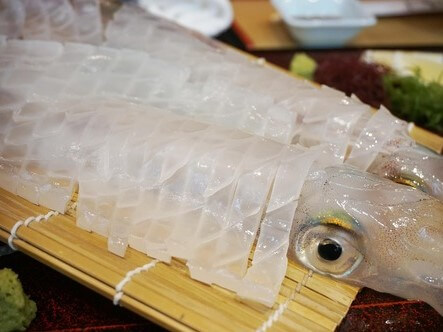 Ikezukuri means to take a fish that’s swimming in a tank at the restaurant, and immediately making sashimi after killing it, while the meat is still super fresh. In this state, there is no Inosinic acid, but there is quite a show with movement still in the fish and this preparation method gives the best-tasting texture.
Ikezukuri means to take a fish that’s swimming in a tank at the restaurant, and immediately making sashimi after killing it, while the meat is still super fresh. In this state, there is no Inosinic acid, but there is quite a show with movement still in the fish and this preparation method gives the best-tasting texture.
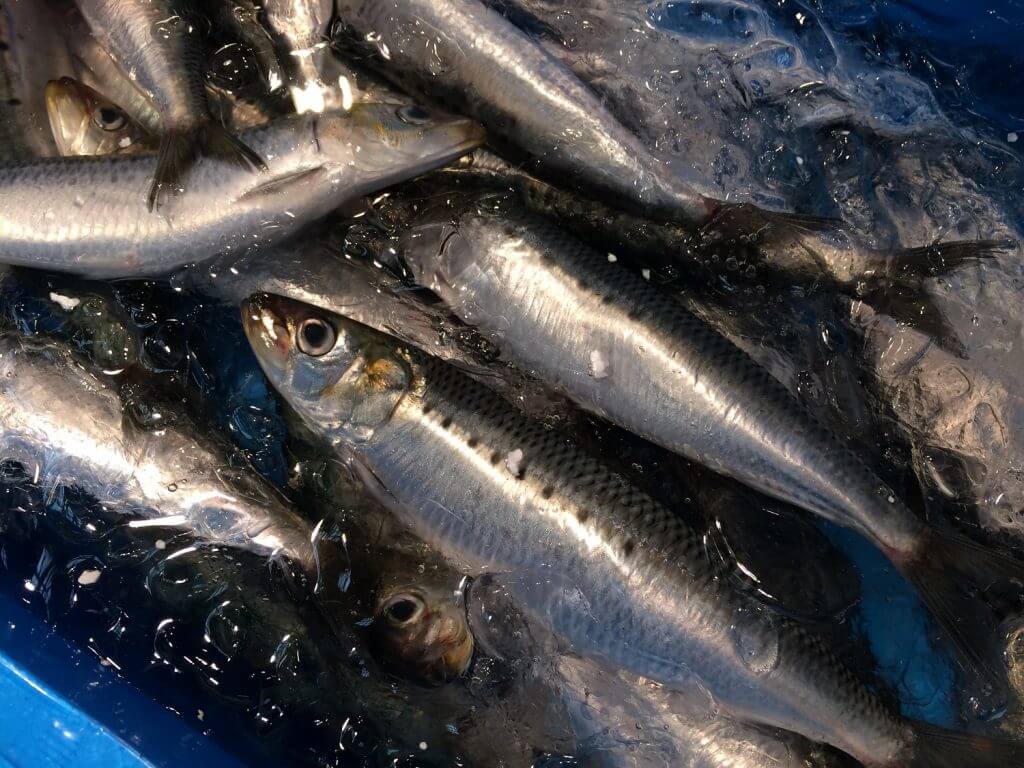 Nojime* means using a massive amount of ice to suddenly reduce the temperature, resulting in the death of the fish, either at the fishing site or at the local market. This method is used for small, cheaper mass-market fish that are caught in large amounts. Nojime starts with a reverse calculation for flavor from the day after fishing, but if the process isn’t thorough or there are any deficiencies, the fish won’t stay as fresh, so detailed care must be taken in temperature management.
Nojime* means using a massive amount of ice to suddenly reduce the temperature, resulting in the death of the fish, either at the fishing site or at the local market. This method is used for small, cheaper mass-market fish that are caught in large amounts. Nojime starts with a reverse calculation for flavor from the day after fishing, but if the process isn’t thorough or there are any deficiencies, the fish won’t stay as fresh, so detailed care must be taken in temperature management.
Hamajime* means to cut the spinal cord at the production site, drain blood and spinal fluid, then pack in ice from the afternoon the next day and wait for the peak flavor, which will be about two days later. That’s when the seafood is shipped to make it to the consumer auction the next day. As time passes, inosinic acid is generated and the aim is to use the fish in sushi at peak flavor.
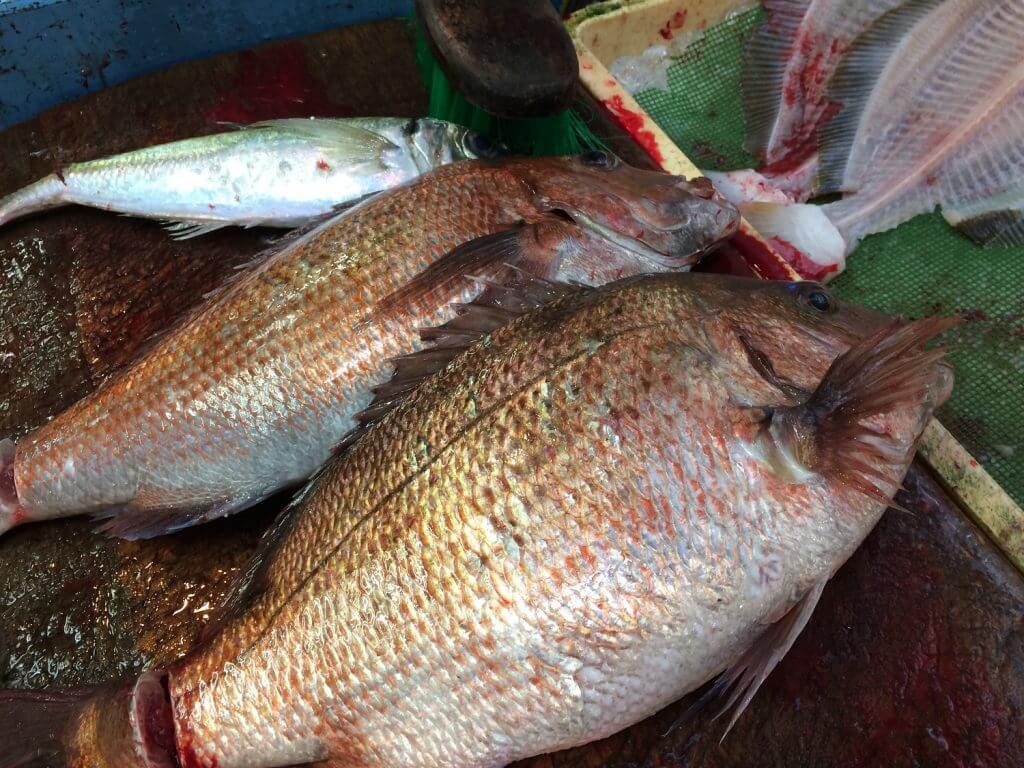 Ikejime is used so that the peak flavor will be reached during afternoon and evening business hours. The spinal cord of the live fish is cut and spinal fluid drained at the early morning market. This result is a firmness from the remaining ATP, and delicious flavor from the Inosinic acid that is generated as time passes. After some time has passed, even fish for which Ikejime is applied, can reach the same state as Hamajime if used after being refrigerated for one to two days, in order to maximize the Inosinic acid generated. Of course, sushi chefs find their own balance of firmness in meat or added flavor, and incorporate this balance for the optimum combination with their shari in each piece of sushi.
Ikejime is used so that the peak flavor will be reached during afternoon and evening business hours. The spinal cord of the live fish is cut and spinal fluid drained at the early morning market. This result is a firmness from the remaining ATP, and delicious flavor from the Inosinic acid that is generated as time passes. After some time has passed, even fish for which Ikejime is applied, can reach the same state as Hamajime if used after being refrigerated for one to two days, in order to maximize the Inosinic acid generated. Of course, sushi chefs find their own balance of firmness in meat or added flavor, and incorporate this balance for the optimum combination with their shari in each piece of sushi.
Finally, maintaining freshness by using Ikejime, has become common practice overseas, and the term “Ikejime” has also become standard among the fishing industry. There are many websites that go into further detail on Ikejime, which you can reference from the links below.
*At markets in Japan, the term “kill” is not used for living fish, instead the word “shimeru” meaning “close” or “tighten” is used. This expression is thought to have come from the sentiment of showing respect and appreciation for all living beings, not only humans.
Related Contents:
Première poissonnerie ikejime à Paris
Le poisson ikejime, la technique ancestrale venue du japon
L’ikejime, cet art japonais qui sublime le poisson
Technique Thursdays: Ike Jime, The Japanese Slaughter Method For Tastier Fish
Ikejime: a humane way to kill fish that makes them tastier
TYPES OF EDO-STYLE PREPARATIONS
[sc_apply url=”https://sushiuniversity.jp/apply/”]
We hope this information will be helpful.

Revision date: May 1, 2020
Share this article
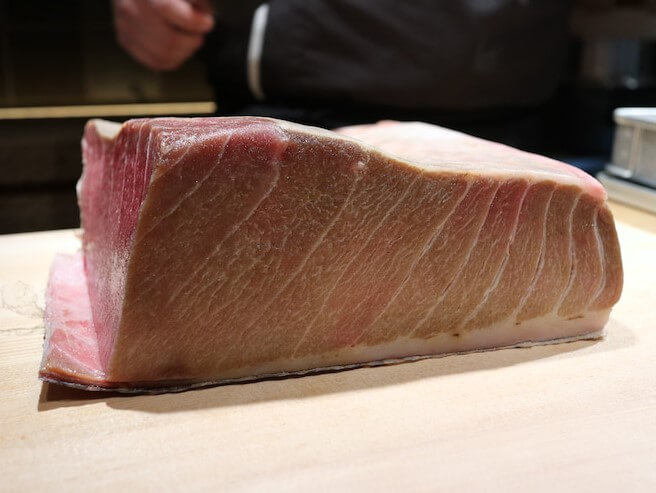 The fish used in sushi is generally salted or soaked in vinegar then matured for several days while the umami Inosinic acid component increases. This is called “Jukusei” (aging). Sushi made with toppings that have been aged in this way is called “Jukusei sushi”. The aging period depends on the type, individual size and origin of each fish, and some are even aged for over four weeks. However, the preparations are not only difficult and time-consuming, but the discolored parts and inedible parts must also be trimmed, so these toppings tend to be expensive. If gone too far, the Inosinic acid converts to hypoxanthine and rots. The ability to make this judgment is important. In the end, Jukusei is an evolved version of the culture of “maturing toppings” which existed in Edo-style Sushi.
The fish used in sushi is generally salted or soaked in vinegar then matured for several days while the umami Inosinic acid component increases. This is called “Jukusei” (aging). Sushi made with toppings that have been aged in this way is called “Jukusei sushi”. The aging period depends on the type, individual size and origin of each fish, and some are even aged for over four weeks. However, the preparations are not only difficult and time-consuming, but the discolored parts and inedible parts must also be trimmed, so these toppings tend to be expensive. If gone too far, the Inosinic acid converts to hypoxanthine and rots. The ability to make this judgment is important. In the end, Jukusei is an evolved version of the culture of “maturing toppings” which existed in Edo-style Sushi.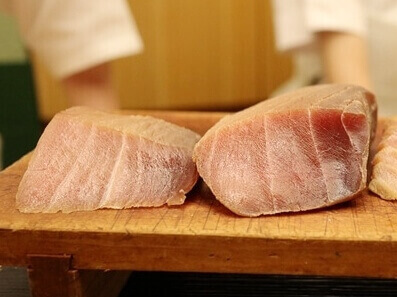 In order to mature seafood, after completing advance preparations (removing the head and internal organs then washing thoroughly; all blood must be removed), more than adequate considerations must be made for the fat content of the fish and management of the bodily fluids. Specifically, this includes processes like dry-aging at a low temperature, removing moisture using salt, utilizing enzymes and fermentation, wet aging by putting the item in a vacuum pack, and wrapping in aging sheets, which were developed thanks to
In order to mature seafood, after completing advance preparations (removing the head and internal organs then washing thoroughly; all blood must be removed), more than adequate considerations must be made for the fat content of the fish and management of the bodily fluids. Specifically, this includes processes like dry-aging at a low temperature, removing moisture using salt, utilizing enzymes and fermentation, wet aging by putting the item in a vacuum pack, and wrapping in aging sheets, which were developed thanks to 
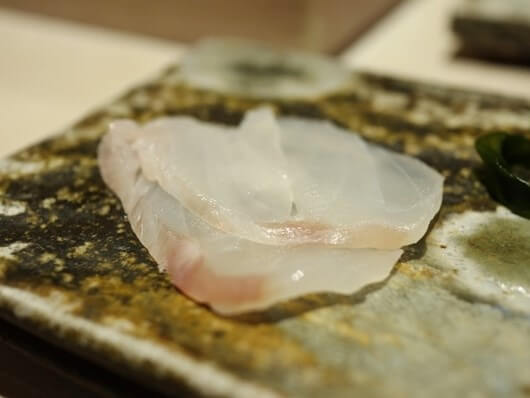
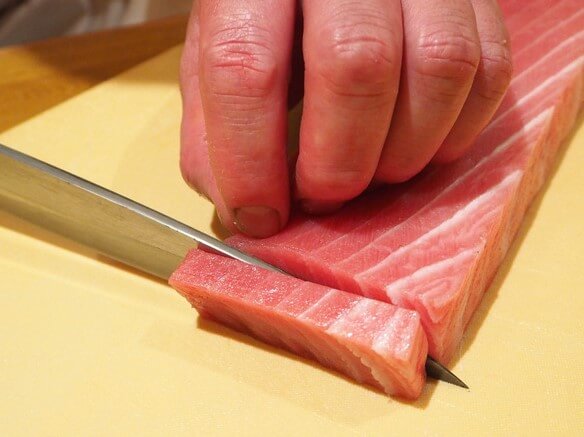
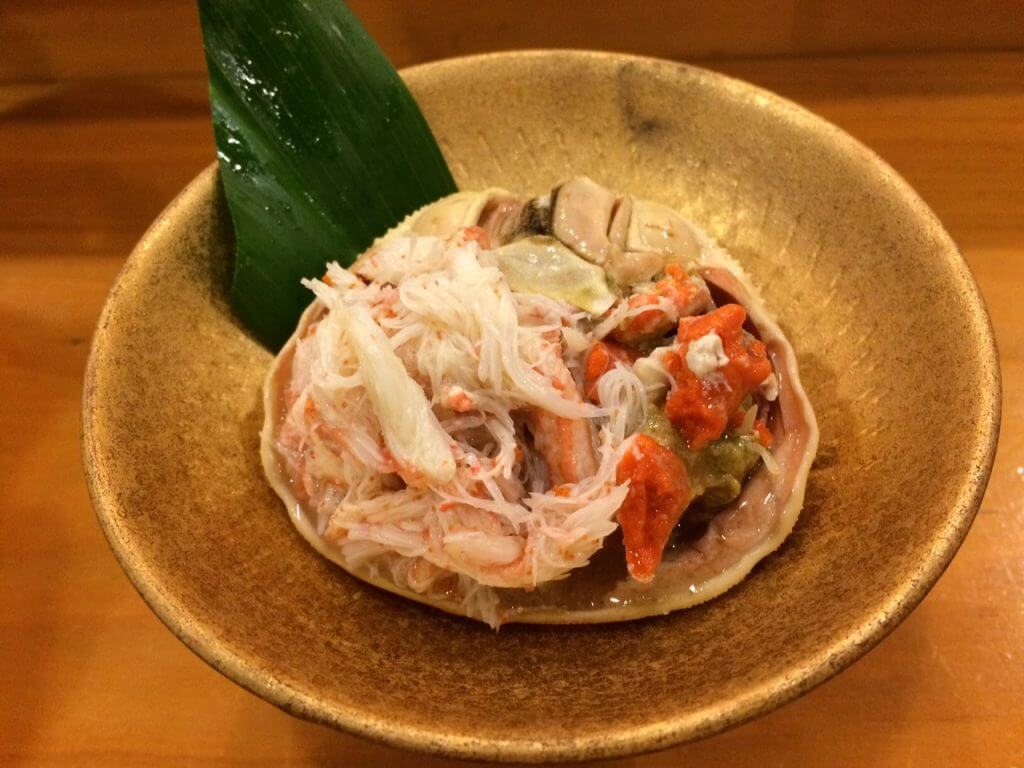
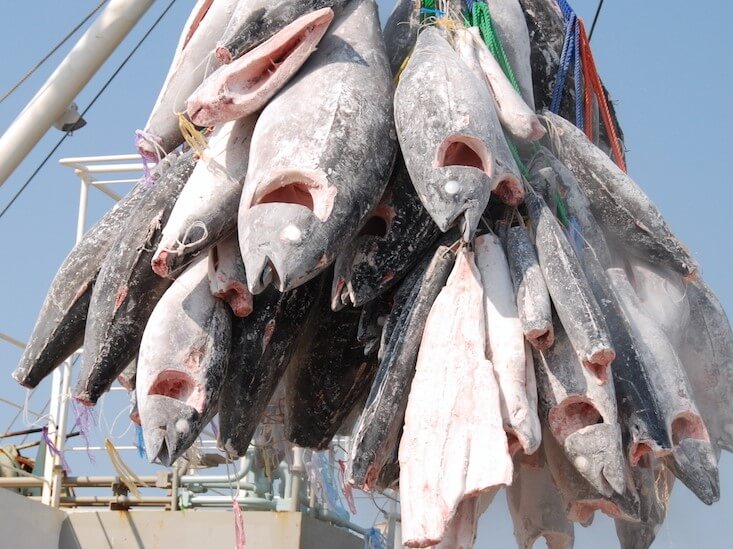 Once tuna caught in the open sea is processed by draining its blood on the ship, it is flash-frozen at ultra-low temperatures (-60℃). Ultra-low temperatures stops the enzymatic hydrolosis of protein, oxidation of fat and cultivation of microorganisms so it can be stored over a long period of time. The process can prevent discoloration for over two years and maintain a freshness worthy of being served as sashimi. Therefore, skillful sushi restaurants mature the thawed tuna in the refrigerator for about one week to attain the perfect balance of umami and change in color.
Once tuna caught in the open sea is processed by draining its blood on the ship, it is flash-frozen at ultra-low temperatures (-60℃). Ultra-low temperatures stops the enzymatic hydrolosis of protein, oxidation of fat and cultivation of microorganisms so it can be stored over a long period of time. The process can prevent discoloration for over two years and maintain a freshness worthy of being served as sashimi. Therefore, skillful sushi restaurants mature the thawed tuna in the refrigerator for about one week to attain the perfect balance of umami and change in color.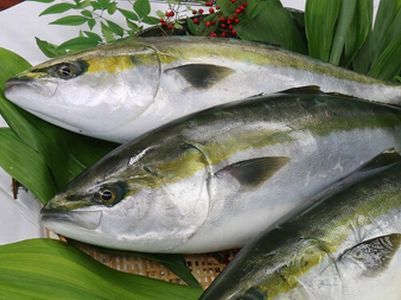 In the United States and other countries, “
In the United States and other countries, “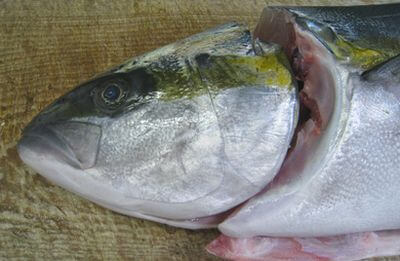 As an aside, three cousins (closely related species) of buri are often used as sushi toppings in sushi restaurants. In the Fish Name Dictionary, the translations of these cousins are Goldstriped amberjack (
As an aside, three cousins (closely related species) of buri are often used as sushi toppings in sushi restaurants. In the Fish Name Dictionary, the translations of these cousins are Goldstriped amberjack (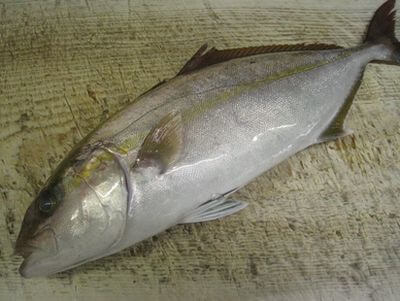 I’m sure you’re interested in the price, and while the price of the seasonal winter buri varies, it is generally around $10-20 per kilogram. Since there is very little distribution of hiramasa, the price is said to be about double that of buri. The price of
I’m sure you’re interested in the price, and while the price of the seasonal winter buri varies, it is generally around $10-20 per kilogram. Since there is very little distribution of hiramasa, the price is said to be about double that of buri. The price of 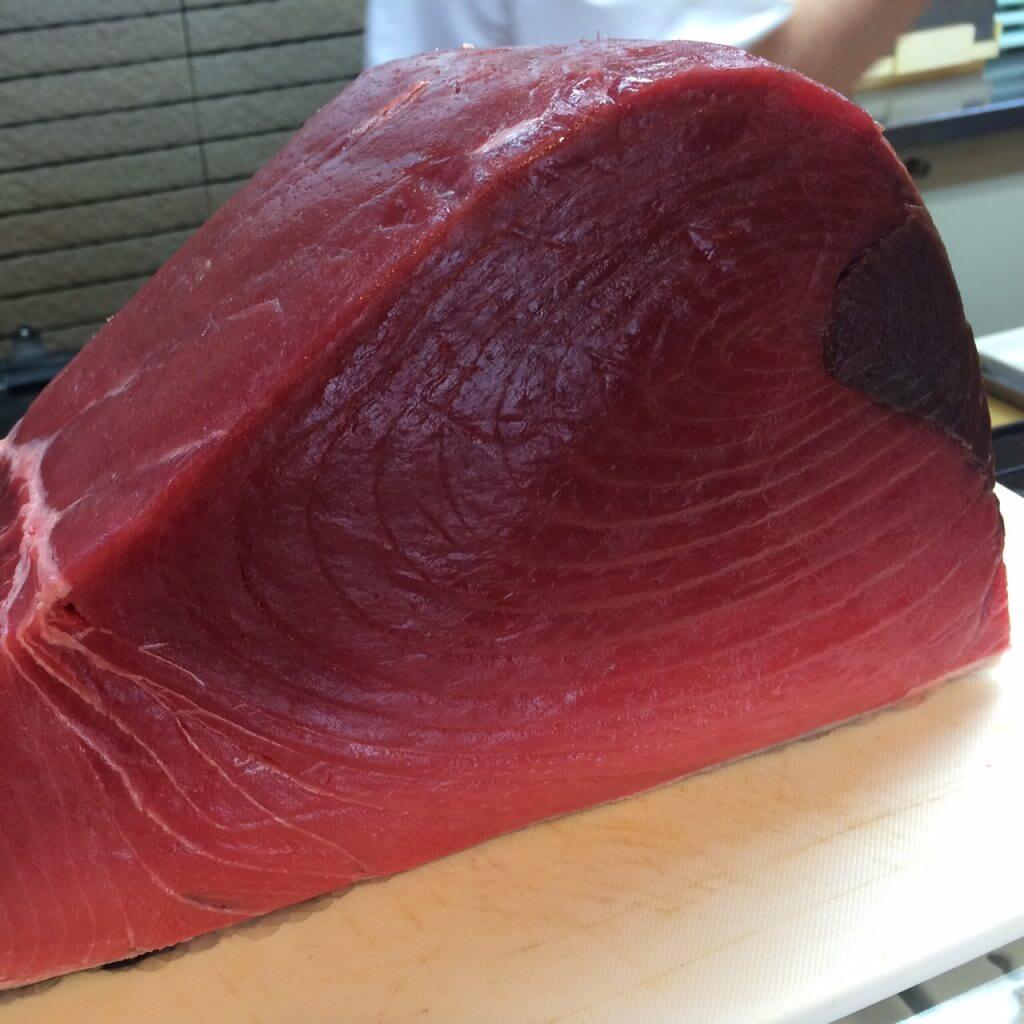 Why is only tuna brought into certain ports high-priced, even though all of the tuna is caught in the seas near Japan? This is because the level of stress caused to the fish when it is caught has a huge impact on the quality, including taste, color and texture. In other words, the same fish may be delicious or taste unpleasant depending on how the fisher handles the fish directly after catching it. Naturally, everyone ends up wanting the fish from the ports with fisherman who are skilled in this practice*. Furthermore, it is individuals who process the fish. The quality changes drastically depending on who caught it.
Why is only tuna brought into certain ports high-priced, even though all of the tuna is caught in the seas near Japan? This is because the level of stress caused to the fish when it is caught has a huge impact on the quality, including taste, color and texture. In other words, the same fish may be delicious or taste unpleasant depending on how the fisher handles the fish directly after catching it. Naturally, everyone ends up wanting the fish from the ports with fisherman who are skilled in this practice*. Furthermore, it is individuals who process the fish. The quality changes drastically depending on who caught it.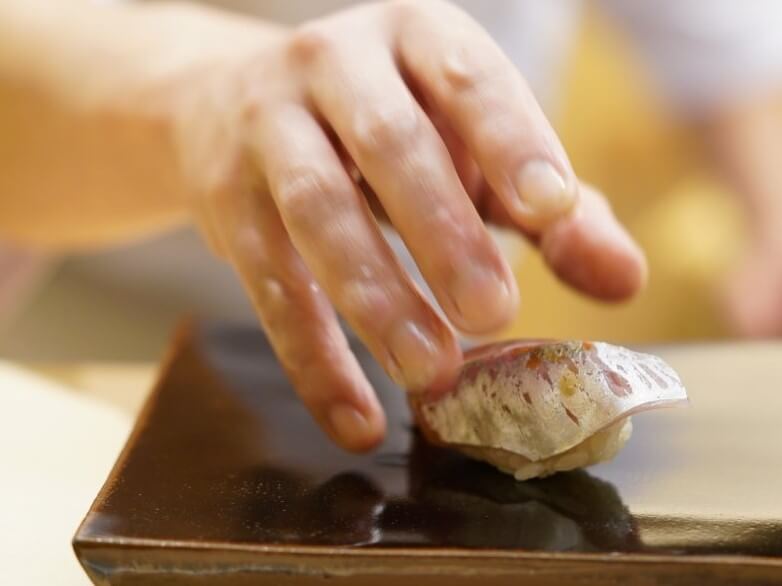 Even Japanese people can be overwhelmed by the somehow special atmosphere when they sit down at the sushi counter. This continues even when starting to eat. Other customers are concentrating on eating, quietly. You kind of get the feeling that if you utter anything, you will be asked to leave. If you don’t end up mustering up the courage, you just end up paying the high price for your meal and going home without much more to say of the evening.
Even Japanese people can be overwhelmed by the somehow special atmosphere when they sit down at the sushi counter. This continues even when starting to eat. Other customers are concentrating on eating, quietly. You kind of get the feeling that if you utter anything, you will be asked to leave. If you don’t end up mustering up the courage, you just end up paying the high price for your meal and going home without much more to say of the evening.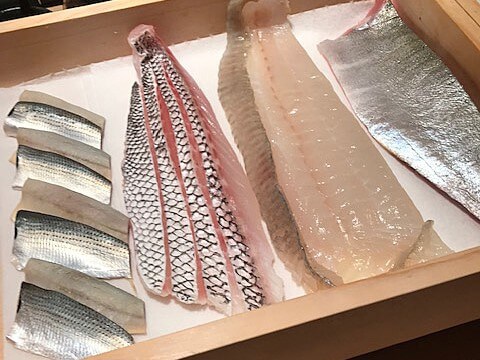 The customer ends up not remembering which fish they ate. For example there are very few people who can name the order of the 15-piece Omakase course they ate. You may be sure you ate tuna. But where was it caught? Was it the belly side or the back side? How long had the fish been matured? To be a bit more frank, how much did it cost? If you ask the chef these questions, next time you visit, you’ll be able to compare different taste based on the fishing location. Knowing the difference in taste based on the part of the fish, and difference in flavor depending on where it was procured, and different taste depending on the preparations will certainly improve your sushi literacy remarkably. It will also lead to a better awareness of your own taste preferences.
The customer ends up not remembering which fish they ate. For example there are very few people who can name the order of the 15-piece Omakase course they ate. You may be sure you ate tuna. But where was it caught? Was it the belly side or the back side? How long had the fish been matured? To be a bit more frank, how much did it cost? If you ask the chef these questions, next time you visit, you’ll be able to compare different taste based on the fishing location. Knowing the difference in taste based on the part of the fish, and difference in flavor depending on where it was procured, and different taste depending on the preparations will certainly improve your sushi literacy remarkably. It will also lead to a better awareness of your own taste preferences.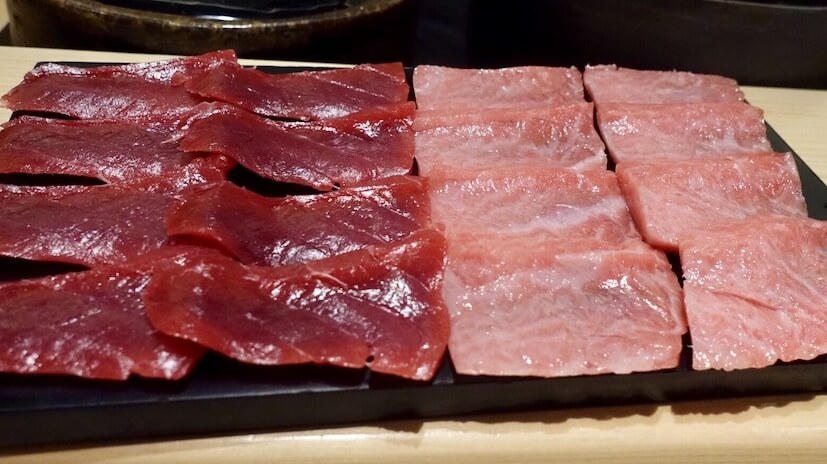 However, sushi chefs will remove the topping from the refrigerator and leave it standing out for a while (in the case of tuna, the fat will melt at around 23℃). They do this because if the topping is cold, it becomes difficult to taste the essential nature of the fish. The temperature of the shari is best at human skin temperature (around 36℃) to maximize the taste and sweetness of the rice. However, the ideal temperature differs very slightly depending on the topping.
However, sushi chefs will remove the topping from the refrigerator and leave it standing out for a while (in the case of tuna, the fat will melt at around 23℃). They do this because if the topping is cold, it becomes difficult to taste the essential nature of the fish. The temperature of the shari is best at human skin temperature (around 36℃) to maximize the taste and sweetness of the rice. However, the ideal temperature differs very slightly depending on the topping.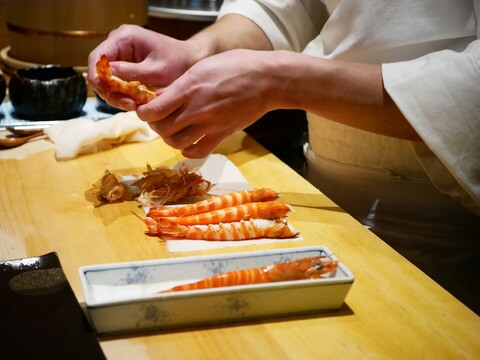 For example, conger eel which is often lightly grilled or prepared in another, similar way, should have a slightly higher temperature (around 42℃) than the shari, and kuruma prawn, which are boiled, should be the same temperature as the shari.
For example, conger eel which is often lightly grilled or prepared in another, similar way, should have a slightly higher temperature (around 42℃) than the shari, and kuruma prawn, which are boiled, should be the same temperature as the shari.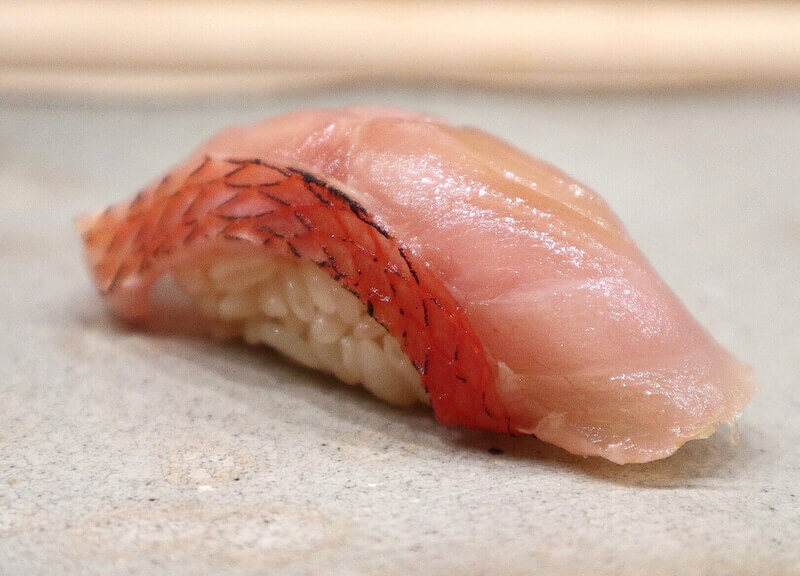 No one is more sensitive to the changing of the seasons than sushi lovers. This must be because the taste of sushi toppings is directly tied to the seasons. There are terms to describe this such as Hashiri (early season), Sakari (in-season) and Nagori (late season), and using these words to understand what state the sushi topping is it allows you to grasp and enjoy the various different flavors. There is nothing that says a sushi topping is less delicious because it has a lower fat content.
No one is more sensitive to the changing of the seasons than sushi lovers. This must be because the taste of sushi toppings is directly tied to the seasons. There are terms to describe this such as Hashiri (early season), Sakari (in-season) and Nagori (late season), and using these words to understand what state the sushi topping is it allows you to grasp and enjoy the various different flavors. There is nothing that says a sushi topping is less delicious because it has a lower fat content.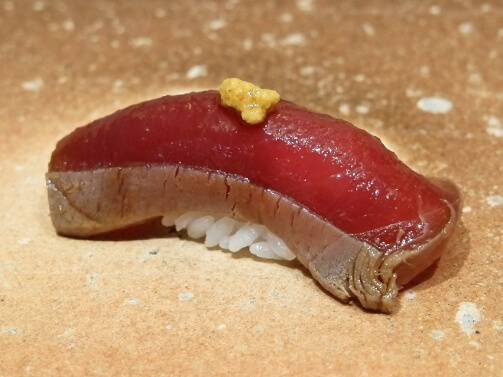 Japanese mustard refers to
Japanese mustard refers to 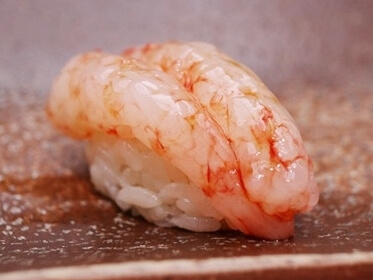 Fish seasons are categorized as the ‘catch season’ and the ‘flavor season’. The ‘catch season’ is the time when lots of fish can be caught and are cheap. Take Japanese Spanish mackerel (Sawara), for example, they approach the coasts during the spring to spawn and this is the peak season. This is the catch season. Once they’re about to spawn and their bodies fatten for winter, we’ve entered the tasting season. However, these seasons differ depending on the region, and may be longer or even happen twice a year.
Fish seasons are categorized as the ‘catch season’ and the ‘flavor season’. The ‘catch season’ is the time when lots of fish can be caught and are cheap. Take Japanese Spanish mackerel (Sawara), for example, they approach the coasts during the spring to spawn and this is the peak season. This is the catch season. Once they’re about to spawn and their bodies fatten for winter, we’ve entered the tasting season. However, these seasons differ depending on the region, and may be longer or even happen twice a year.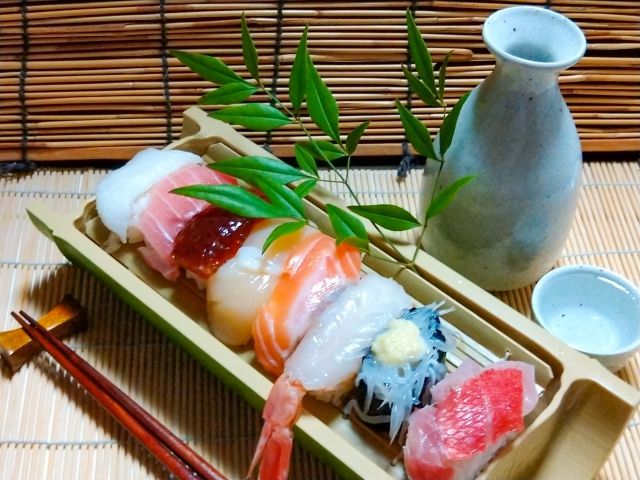
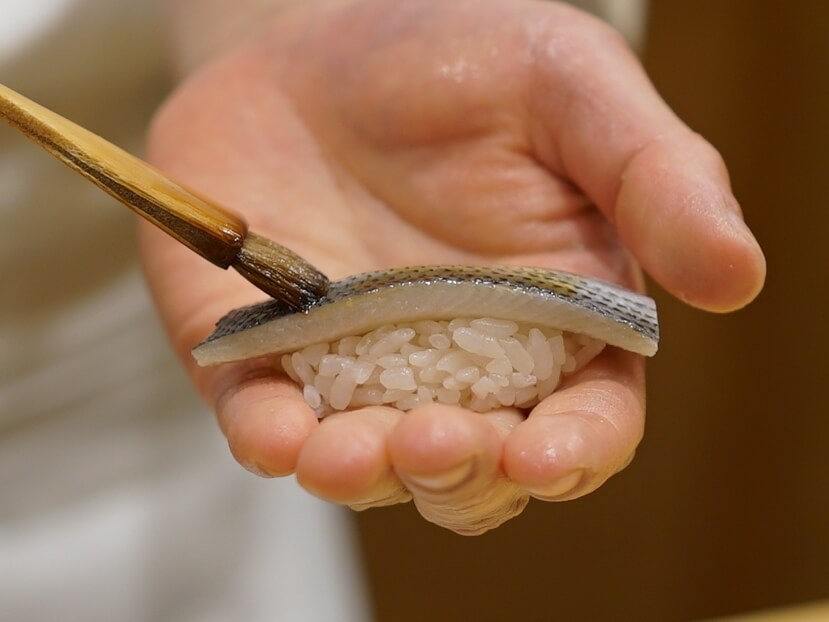 At high-class restaurants, the minimum required nikiri soy sauce is brushed on to the piece, but at restaurants frequented by the general public, customers dip their sushi in as much sauce (soy sauce that includes chemical seasonings) as they like. In fact, there is a gimmick here. The high-class restaurant provides an opportunity for their customers to eat sushi toppings in the most delicious state possible, but the restaurants for the general population allow customers to eat casually with sauce, a daily necessity. This changes how topping ingredients are selected. If the sushi is going to be dunked into the soy sauce, then the topping must have an appropriate fat content that won’t be overpowered by the soy sauce. Therefore, instead of a coastal tuna, a farm-fattened tuna with oily fat is preferred. It is often said that farm-fattened products are too rich, but it is also said that they have an impact that isn’t overpowered by the sauce they are enjoyed with.
At high-class restaurants, the minimum required nikiri soy sauce is brushed on to the piece, but at restaurants frequented by the general public, customers dip their sushi in as much sauce (soy sauce that includes chemical seasonings) as they like. In fact, there is a gimmick here. The high-class restaurant provides an opportunity for their customers to eat sushi toppings in the most delicious state possible, but the restaurants for the general population allow customers to eat casually with sauce, a daily necessity. This changes how topping ingredients are selected. If the sushi is going to be dunked into the soy sauce, then the topping must have an appropriate fat content that won’t be overpowered by the soy sauce. Therefore, instead of a coastal tuna, a farm-fattened tuna with oily fat is preferred. It is often said that farm-fattened products are too rich, but it is also said that they have an impact that isn’t overpowered by the sauce they are enjoyed with.